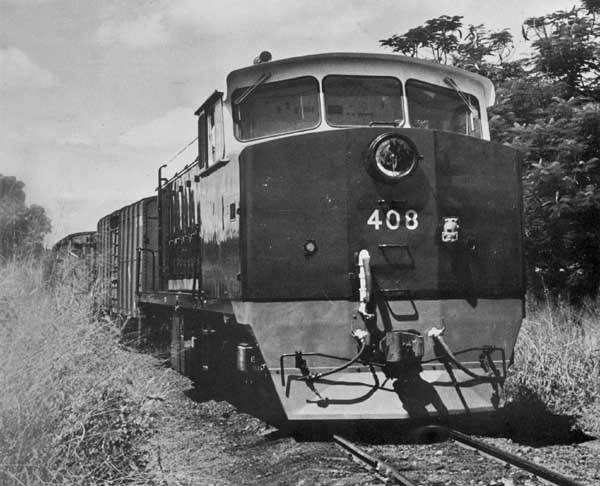
Whilst the British Railways workshops at Derby & Darlington were establishing production lines for the Class 25s, another workshop, at Metropolitan Cammell, Birmingham were constructing a series of locomotives utilising similar components found in the British Railways machines. Although the African locomotives were 3'6" gauge Co-Co's with a single cab and a 'hood' syle body, they represent an alternative design to the BR Derby style for a similar power rating.
The basic type, more commonly known as the 'Zambesi' Class eventually totalled fifty three locomotives built between 1962 & 1969 - in Nigeria the locomotives, which were slightly more powerful, were named and became known as the 'Station Class'.
The first order #61187 dated March 14th 1962 was for eight locomotives delivered in 1963, five to Nyasaland (#200 - 204), three to Trans-Zambesia Railway Co Ltd in Mozambique (#205 - 207). Joint management of Malawi Railways and the Trans-Zambesia Railway was discontinued in 1967 when 93% of the British owned share of the latter was bought by the Portuguese government. From that time the line was operated from Beira as part of the Beira Division of CFM.
Order #61251 dated March 30th 1964 for twenty nine locomotives, delivered March 1965 - 1966 for Nigerian Railways (#1401 - 1429), though four were diverted to the Zambian Government in 1965 for Zambia traffic and were shipped through Malawi, these last four were known as the 'Station' Class in Malawi (#1425-1428).
Order #61283 replaced the four Nigerian locomotives diverted to Zambia in 1965. These four replacements kept their original intended road numbers (#1425-1428) and were delivered in 1966.
Order ?? dated June 14th 1966 for seven locomotives for the Trans-Zambesia Railway (#208-214) delivered 1968 & 1969.
Order 612?? of July 19th 1966 for five locomotives for Malawi, delivered 1968 (#405 - 409)
![]() Nyasaland & Trans-Zambesia Railway
Nyasaland & Trans-Zambesia Railway
Twenty locomotives in four orders were delivered to the narrow gauge (3ft 6in) Nyasaland & Trans-Zambesia Railway between 1962 & 1968, all powered by the Sulzer 6LDA28B power unit.
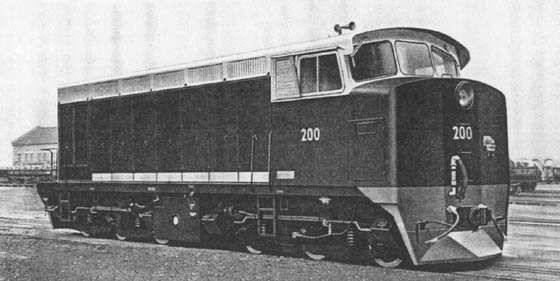
For the delivery of eight 1,200hp diesel-electric locomotives to the Nyasaland & Trans-Zambesi Railway, the choice of power unit was the Sulzer 6LDA28B producing 1,200hp at 750rpm. The contract had been placed with Associated Electrical Industries (AEI) with the mechanical parts built by Metropolitan Cammell Carriage & Wagon Co Ltd, Saltley, Birmingham, consulting engineers were Messrs Livesey & Hendersen. The power unit was identical to those supplied to British Railways for its large fleet of Class 25's, being a six cylinder pressure charged, intercooled unit with a cylinder bore of 280mm and a stroke of 360mm. The inter-cooler cooling was included in the engine cooling circuit and an engine-mounted heat exchanger was fitted for lubricating oil temperature control. The circulation of engine cooling water and of lubricating oil priming was by an independent motor driven pump set which allowed circulation prior to engine starting and after shut down.


Engine speed was controlled by a stepless pneumatic control unit. The protection equipment fitted was an engine shutdown to prevent damage from loss of coolant and from failure of lubricating oil pressure. Sound alarms indicate high water temperature, wheel slip or earth faults. Engine starting was by motoring the generator from the battery.
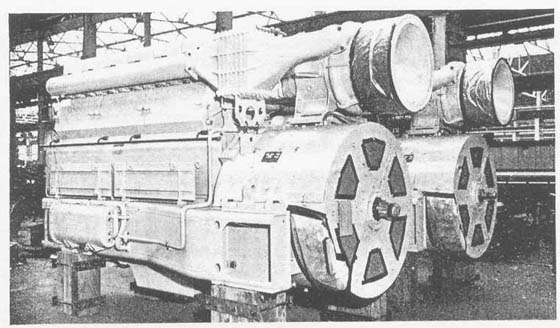
AEI provided an RTB15656 main generator, a single bearing 12 pole self ventilating machine with self and separately excited shunt fields together with a decompounding series field. Rating was 750rpm of 1500A at 515V or 1090A at 710V. The armature was solidly connected to the engine crankshaft. Class H insulation was used on the armature & fields. The AEI patented 'Pollock' type commutator construction was used. The hydraulically operated load regulator was linked to the engine governor and controlled the separately excited field to match the generator output to the engine. The auxiliary generator was an AEI AG51AZ, rated at 18kw at 110V, supplying power for the combined pump set, brake exhauster, lighting, control circuits and battery charging. The drive was by vee belts from the rear of the main generator. The fan for the rear bogie traction motor blower was on the auxiliary generator shaft.
The locomotive was carried on two three axle bogies with equal axle loading, each bogie carrying three AEI 253AZ axle hung traction motors. These were four pole series wound motors, in service worldwide in a variety of different types & sizes of locomotives. The motors were Class H insulated with a high continuous rating, equal to 22% adhesion, suitable for the heaviest trains on the most difficult grades. The six motors were in permanent series pairs and provided with three stages of field shunt. These were obtained by an electrically driven programme switch controlled by the load regulator and current relays which give automatic up-shunting & down shunting. The control equipment was mounted in a cubicle adjacent to the driver's cab and accessible from it.

The bogies were of the Alsthom type in which the body is carried on two rubber cone pivots and four side bearers. The inner pivot assembly on each bogie can slide as a unit on manganese pads allowing negotiation of tight curves. The height of the side bearers which are spring loaded can be adjusted to vary the proportion of weight carried by the pivots. Each axlebox is carried by two radius rods attached to the bogie frame. Silentbloc bushes are fitted to the rods to permit limited lateral movement and to reduce maintenance. Primary suspension is by coil springs carried on underslung equalising beams. A vacuum controlled straight air brake is fitted, brake rigging is of the single-shoe type type and is operated by two cylinders on each bogie. Air for the brakes is supplied by a mechanically driven compressor. A two speed motor driven exhaustor powers the vacuum brake system
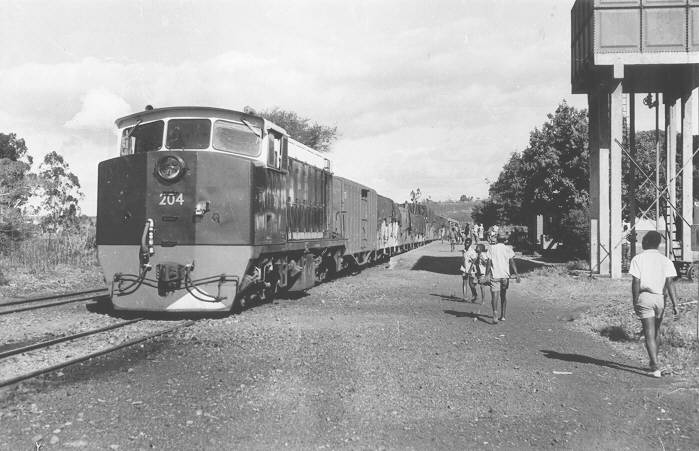
The mechanical portion comprised a general purpose single cab design which could easily be modified to suit other railways operating requirements without changing the main equipment layout. Length over headstocks was 43ft 1in, axle loads did not exceed 13.5 tons whilst total weight in working order was 81 tons.
Modifications include a reduction in axle loading, addition of dynamic brakes, a reduction in the body measurements. Alternative cab styles and axles gauges are available as is an increase of the engine output to 1,400hp. The Nyasaland superstructure is of the hood type with one full width cab and short nose. The engine-generator set is roughly located in the center of the locomotive. Radiators are side mounted at the end of the long hood, air is drawn through them via a roof mounted fan. The fan drive is by the diesel engine through cardan shafts, a right angle gearbox and an eddy current clutch. This clutch is under thermostatic control to maintain optimum engine temperature. The leading bogie traction motor blower is placed between the engine and the radiator and is driven by vee belts from the radiator fan drive shaft. Also located in this area are the electrically driven pump group and vacuum exhauster. A combined auxiliary generator & traction motor blower, vee belt driven from the main generator, and a directly driven compressor are mounted on the rear of the main generator assembly. The control equipment is located at the end of the hood adjacent to the driver's cab. All air entering the engine is filtered through dry filter panels set high in the hood side and protected by storm louvres. Batteries are located in the short nose and a 920 gallon fuel tank is slung under the frame between the bogies.
The underframe is made up of two main longitudinal sills, strengthed by welded cross members and covered by a continuously sealed cross plate. Drag boxes are attached to these and carry the standard buck-eye coupler found on through services in Southern Africa. The hood and cab are constructed in steel sheet on a framework of rolled steel sections. The entire narrow hood can be lifted off as a one piece unit, for less severe maintenance the inspection doors and roof hatches can be removed individually. A separate panel provides sockets for external charging and depot supply connections.
The cabs of the original order only contained one driving position, the intention being to turn the diesels at the end of each run, similiar to steam practice. Later orders saw two driving positions fitted within the cabs, which provided for better locomotive utilisation and some cost savings.
Due to the maximum fuel capacity carried on the original order no inter-bogie control was fitted. However on the later order of Malawi locomotives and the Nigerian order smaller fuel tanks allowed for inter-bogie coupling to be fitted. This device was intended to guide the trailing bogie into curves in the hope of reducing flange force, thus leading to longer tyre and rail life. This was important where the track featured frequent sharp curves and at locations where track replacement was difficult. The original locomotives were later retro-fitted with the inter-bogie couplers.
The first of the locomotives was shipped through Birkenhead during April 1963. They were to be used on the line from Beira to Limbe & Blantyre and beyond. Double heading was necessary on the 66 mile climb to Limbe, which included gradients of 1 in 48, the average gradient was 1 in 100. In service the locomotives averaged about twenty hours per day, though the annual mileage was low, approx 60,000 - 70,000 miles annually.
Principal subcontractors were:
Brake equipment - Davies & Metcalfe Ltd
Brake Cylinders - Westinghouse Brake & Signal Co Ltd
Exhausters - Consolidated Brake & Engineering Co Ltd
Compressor - Worthington-Simpson LTD
Radiators - Serck Radiators Ltd
Radiator Fans - Keith Blackman Ltd
Wheels & Axles - Taylor Bros & Co Ltd
Traction Motor Blowers - Aerex
Batteries - Chloride
Axleboxes - British Timken Division of the Timken Roller Bearing Co.
Automatic Couplers & Drawgear - English Steel Castings Corporation Ltd
Fuel Gauges - Bayham Ltd
Fuel Filler - Lockheed
Windscreen Wipers - Trico-Folberth Ltd
Speedometer - Hasler Telegraph Works Ltd
Air Filters - Intermit Ltd
Diesel Oil Filters - Auto-Klean Strainers Ltd
Lubricating Oil Strainers - Krecht
Lubricating Oil Filters - Fram
Fuel Filters - Purolator
Rubber Pivot Cones - Andre Rubber Co Ltd
Cab Seating - A W Chapman Ltd
Flexible Conduit - Superflexit Ltd
Cable Markers - Siegrist Orel Ltd
Lights - J Stone & Co (Deptford) Ltd
Miniature Circuit Breakers - Chilton Electric Products Ltd
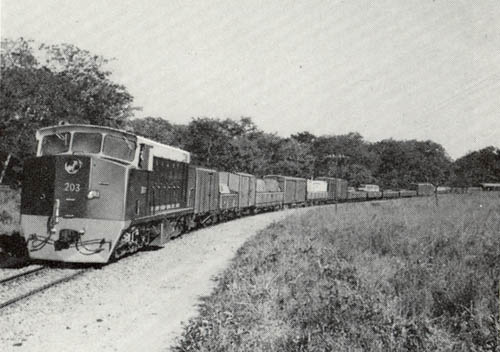
When CFM (Mocambique) took over the line from Beira to the Malawi border in 1967 locomotives 205 - 214 became part of the CFM roster, 200 - 204 became Malawi Railways 400 - 404, later joined by 405 - 409.
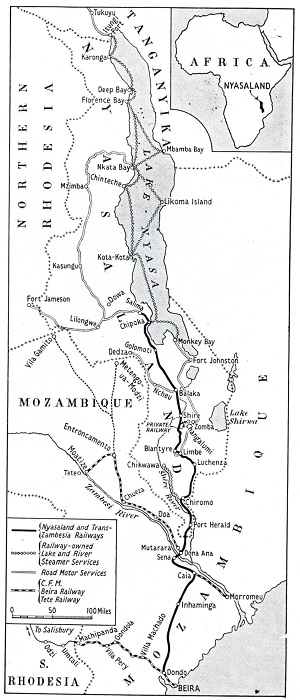
![]()
The information and many of the pictures in the following section has been graciously provided by Peter Bagshawe - Thank You!! (much of the statistical information has been extracted from various Malawi Railways Annual Reports & Statistics).
The Station Class - 1425/26/27/28
When Rhodesia declared UDI in 1965 Zambia took steps to provide alternative routes avoiding Rhodesia for the import/export of goods and raw materials. The port of Nacala, Mozambique was chosen as an alternative shipping point to the existing port of Beira. This new road/rail route passed through Malawi, the extra traffic requiring the purchase of four new locomotives, thus an existing order intended for Nigeria saw four of its locomotives diverted to Malawi. Although operated by Malawi Railways they carried plates stating they were the 'Property of the Zambian Government'. These plates were carried at least until 1989, with Malawi paying hire charges on the locomotives. The locomotives may at a later date have been sold to Malawi Railways.
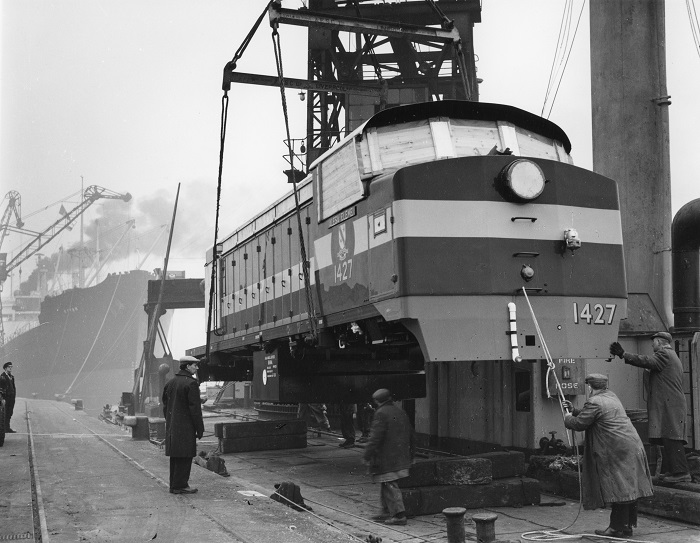
In 1970 1425/1426 were sent to Zambia, but were found troublesome and returned to Malawi in 1971.
Diverted were:
1425 Kafanchan
1426 Zungeru
1427 Alesa Eleme
1428 Mokwa
These were built during 1965 (builder's numbers 1250 - 1253) and were delivered in Nigerian Railways green livery with yellow waistband, fully lettered with Nigerian Railways names and numbers - hence their description as the 'Station Class'.


Operation by Malawi Railways
The initial five Zambesi Class locomotives 200 - 204 (later 400 - 404) were joined by the four Station Class locomotives 1425-1428 in 1965 and the final order of five Zambesi Class locomotives, 405 - 409 during 1968. The total of fourteen remained together until mid 1970 when 1425 & 1426 were recalled by Zambia Railways, passing through Mozambique & Rhodesia in order to reach Zambia.
Whilst in Zambia 1425 & 1426 worked from the Zambia Copperbelt town of Ndola, being allowed 900 tons/76 axles on the Luanshya branch and 800 tons/68 axles on the Kitwe and Sakania lines. Zambia Railways found the locomotives troublesome, particularly the compressors, frequently the locomotives were under repair at the Kabwe workshops. Such were their troubles that by mid 1971 they had been relegated to the Ndola - Bwana Mkubwa trips and the Ndola Industrial sidings shunt. During September 1971 they were returned to Malawi via Rhodesia & Mozambique. Whilst operating out of Ndola 1425 & 1426 frequently worked to Sakania in Zaire (now D.R. Congo) - making these machines somewhat well travelled across five countries. During this time the twelve machines operating on Malawi Railways during 1970 had maintained an availability of 83% with a total mileage of 638,833 miles. During 1971 with fourteen machines available by the end of the year availability reached 88% with a total mileage of 629,832.
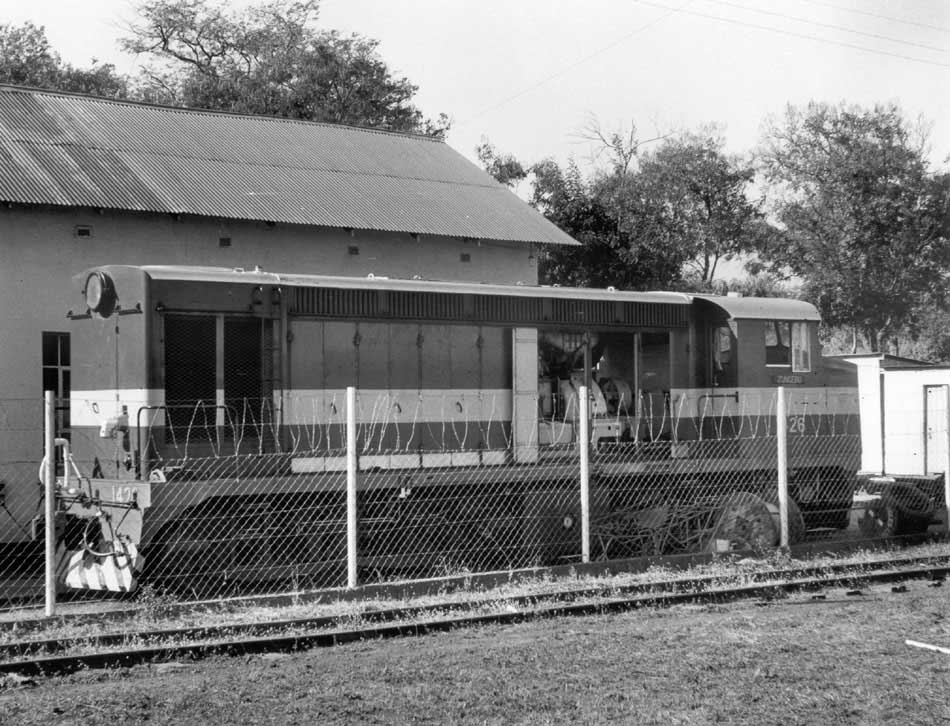
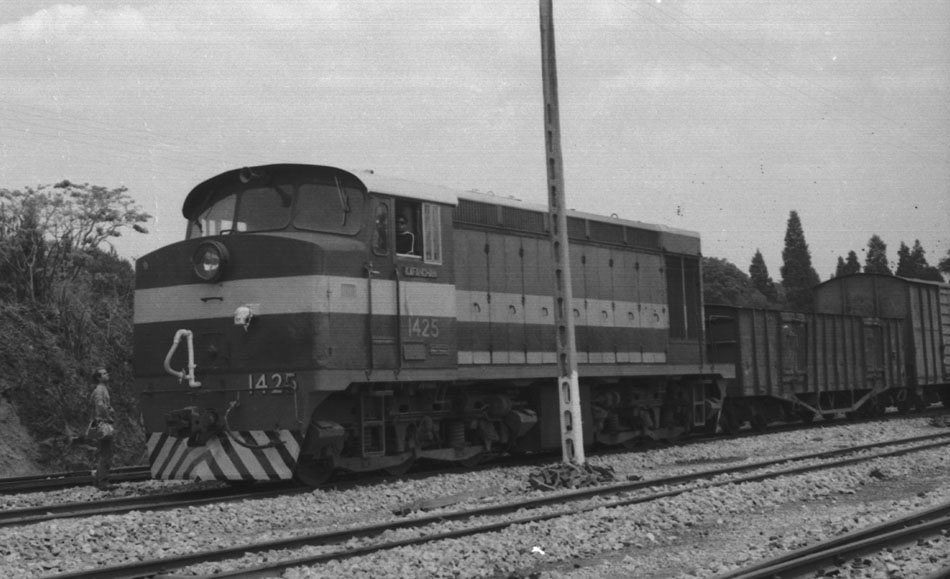
The next two and a half years were perhaps the best for the locomotives, availability remained above 80%, with total milieage peaking at 700,732 in 1973. During the latter half of 1974 the lack of spares caused five locomotives to be taken out of service, reducing total mileage by about 20%. This situation would continue through 1979 with a lack of spares periodically affecting locomotive availability. Turbocharger failures and the delayed delivery of spares during 1975 affected six locomotives by October. By 1977 the failure of a main generator armature gave cause for major concern. Two locomotives were hired to CFM (Mozambique) during 1977. The hire of one locomotive continued through 1978, main generator armature failures continued to be a problem whilst 401 & 403 were out of service for the whole year, 1427 was out of service for eight months.
During 1973 four MLW built Shire Class locomotives arrived to join the Malawi fleet, possibly their arrival mitigated the reduced availability of the Zambesi Class during this period.
Observations in February 1977 found 401 & 408 working (see photograph), whilst 404 & 409 were in the workshops. Also present were Station Class 1425 inside the workshop and 1426 outside, status uncertain. Information at Limbe suggested these locomotives could only work as far as Chipoka - between 1971 & 1977 the line between Balaka and Salima was upgraded to handle heavier locomotives, sources suggested this was already happening but none were observed at Salima on the visit made in February 1977. It was also reported two Zambesi Class were on hire to TZR, one used on the mainline, the other for the Moatize line. They were required due to the wrecking of three of the TZR diesels (200 Class ??) in December 1976. Malawi Railways would have preferred to loan out the Station Class locomotives, they were not as popular as the Zambezi, however contractual reasons relating to their ownership would probably have prevented this.
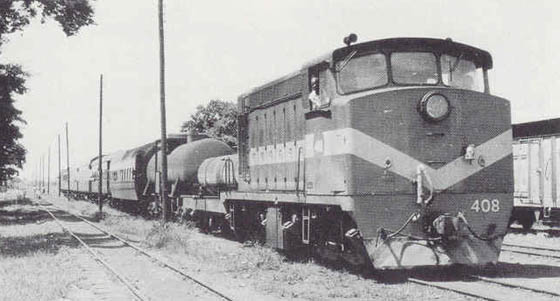
During 1979 availability crept up to 81%, with total mileage being 582,911. These figures were helped by the installation in 409 of a complete power unit from Sulzer and a generator in 401. By year end all locomotives were in service.
During 1981 the Zambesi Class locomotives were frequently on hire to Mozambique, with as many as nine locomotives on hire at one time. In the following years some would be hired out for the whole year, such as 403/404/406 during 1985/86, 1986/87 & 1987/88. In the late 1980's/early 1990's the Malawi Railways locomotives were noted on the Nacala line across the Mozambique border. 401/02/07/08 were fitted with armoured cabs as a caution against land mines, this was later removed. 403/404 were on hire to the CFM when abandoned in Mocambique, 403 at Inhaminga and 404 in section with train near Muanza.
The arrival of a further sixteen Shire Class locomotives from Bombardier - Type MX615 Co-Co 1,500hp diesel electrics during 1980 replaced the Zambesi/Station Class on their regular duties. Because of this the total mileages run up by the Zambesi/Station Class fell dramatically; 34,268 km in 1985/86, 114,634 in 1986/87, 51,048 in the first eleven months of 1987/88 and 56,456 in 1993/94. For these periods only Zambesi Class locomotives 400/01/02/07/08/09 were reported as operating, whilst in the 1993/94 statistical year only 1426 of the Station Class was recorded as operating.
Sometime during the early/mid 1980's one Zambesi Class locomotive was withdrawn following accident damage in Mozambique. Initially this was reported as 405, but later official reports state it was 403. By October 1997 405 had turned up at Limbe with accident damage.
It is documented that all four of the Station class and six of the Zambesi class locomotives operated in the eleven months through to February 1988. Monthly distances recorded in the period since April 1987 were quite similar. In the preceding period to February 1987, the Zambesi class monthly distances were about double those of the Station class.
In the period ended February 1988, three of the Zambesi class had been hired out to CFM Mozambique. That practice had been ongoing, for example during 1981 up to nine of the Zambesi class were hired out to CFM. One, #405, was damaged beyond repair in the 1984-85 period, leaving nine in the fleet.
As previously mentioned, the four Station class members were reported as out of use in November 1988 November and November 1989, but whether the time between was a continuous period out of use is unknown.
Nonetheless the use of a total of ten locomotives from both classes through to early 1988 suggests that MR needed more than its Shire class fleet to move the traffic on offer. No doubt the Tazara Railway, opened in late 1975, would have siphoned off some of the MR traffic, although that may have been a gradual change.
And the fact that CFM needed to hire locomotives from MR indicates that its reasonably large – and growing - GE U20C fleet was insufficient, although it is believed there had been some casualties. Locomotive availability probably suffered during the difficult times, as well.
An interesting question in respect of the 1401 class – and one for which finding the answer is not likely to be easy – is whether or not MR retained the taper axle loading arrangement with which they were built, or reset them for equal axle loadings as on its own Zambesi type. Given that it reset the power output downwards to match the Zambesi, it is not unlikely.
A visit to Malawi in November 1988 revealed that the four Station class were all parked out of use at the workshops, though there was talk of them being returned to service. With the main batch of the newer Shire Class diesels now in service the Zambesi Class had been relegated to lesser duties, that of shunting, local & departmental duties. 400 & 409 were noted working. 400 was initially seen stabled at Balaka, en-route to Limbe after handling work train duties on the Nacala line. It was later seen working the Limbe - Blantyre shuttle. 409 was noted heading south towards Blantyre on a breakdown train. Of the others 403 - 406 were reported on loan to Mozambique (Beira line), of which 405 (?) had been written off in an accident. 401/402/407 were all in use on the Nacala line reconstruction. The whereabouts of 408 was not determined.
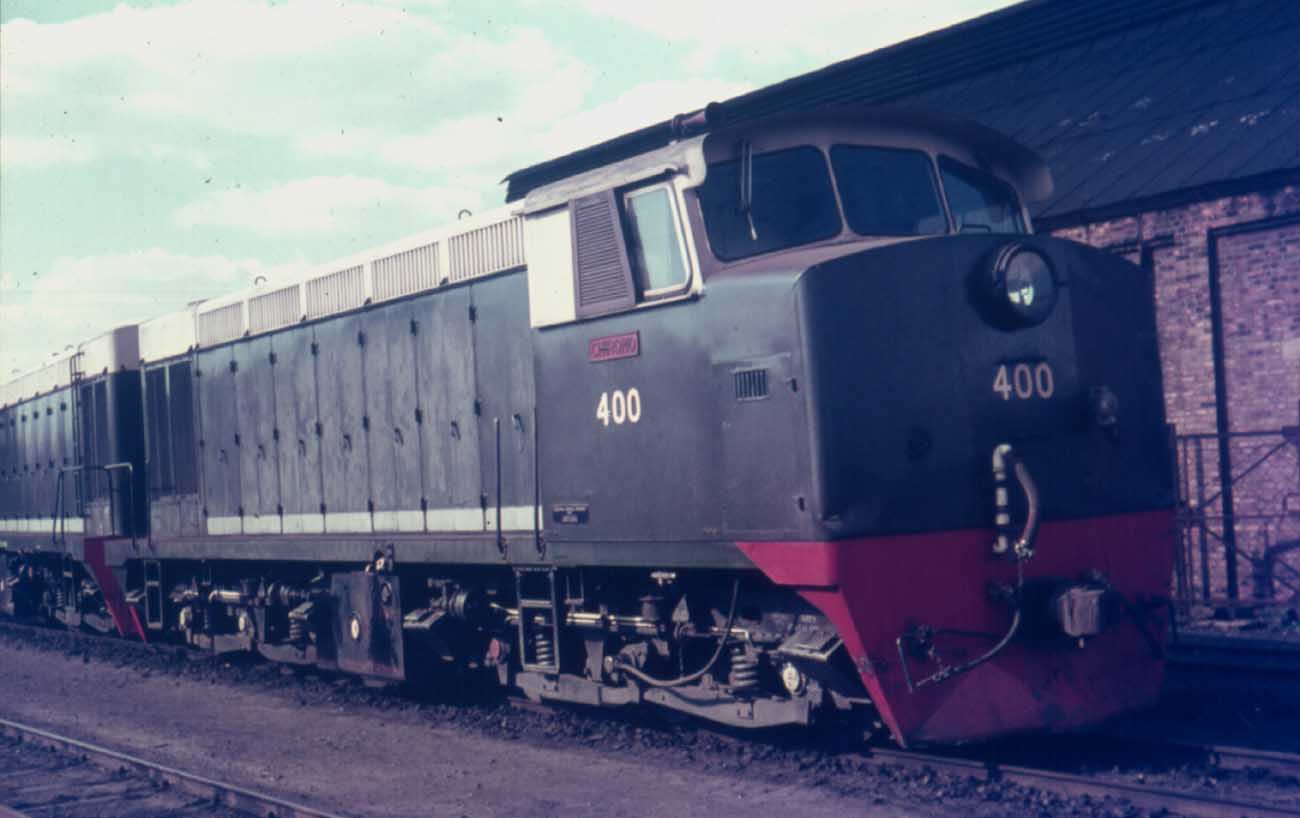
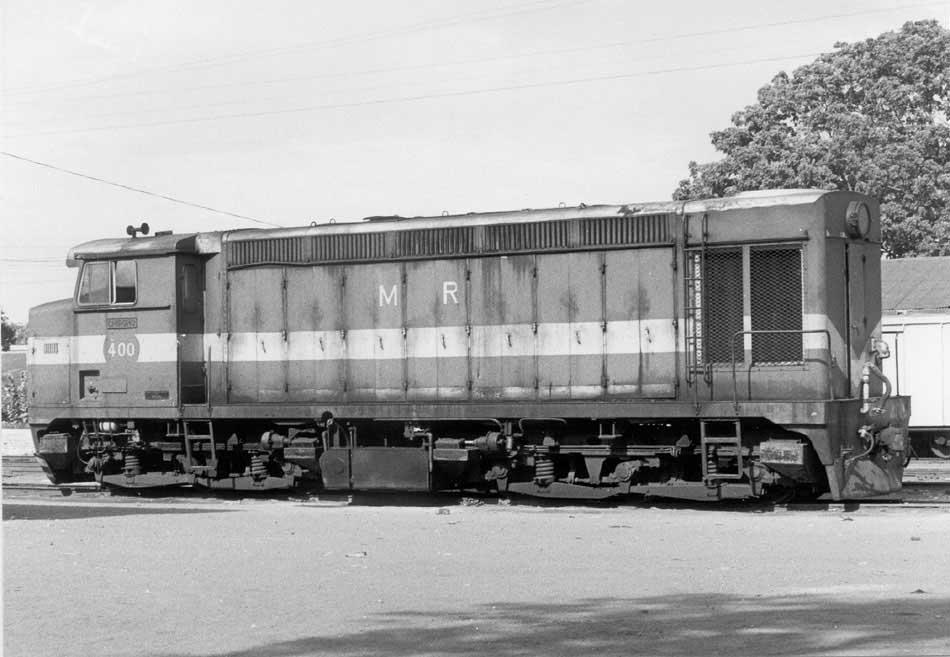
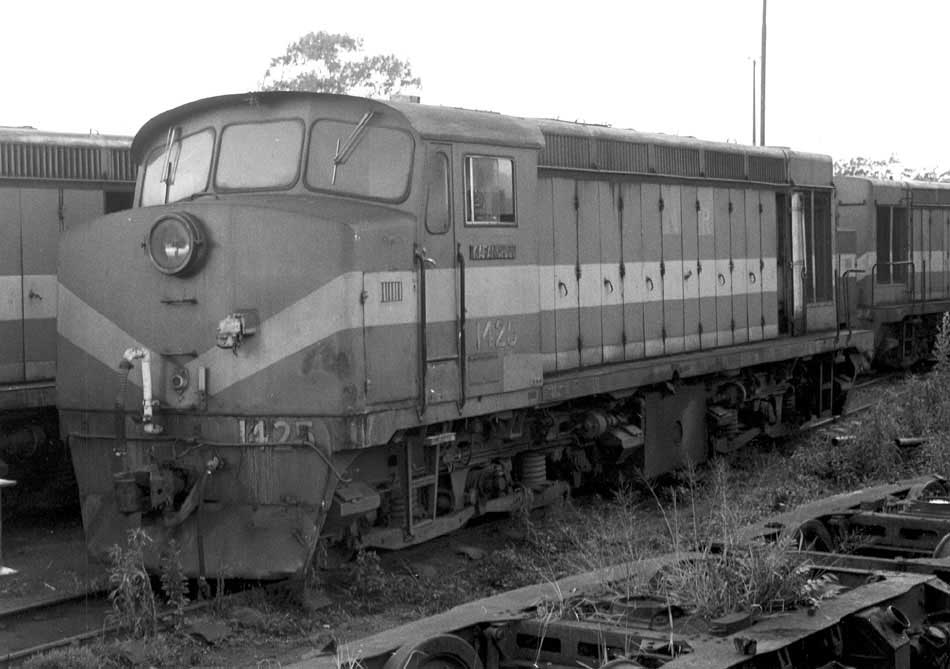
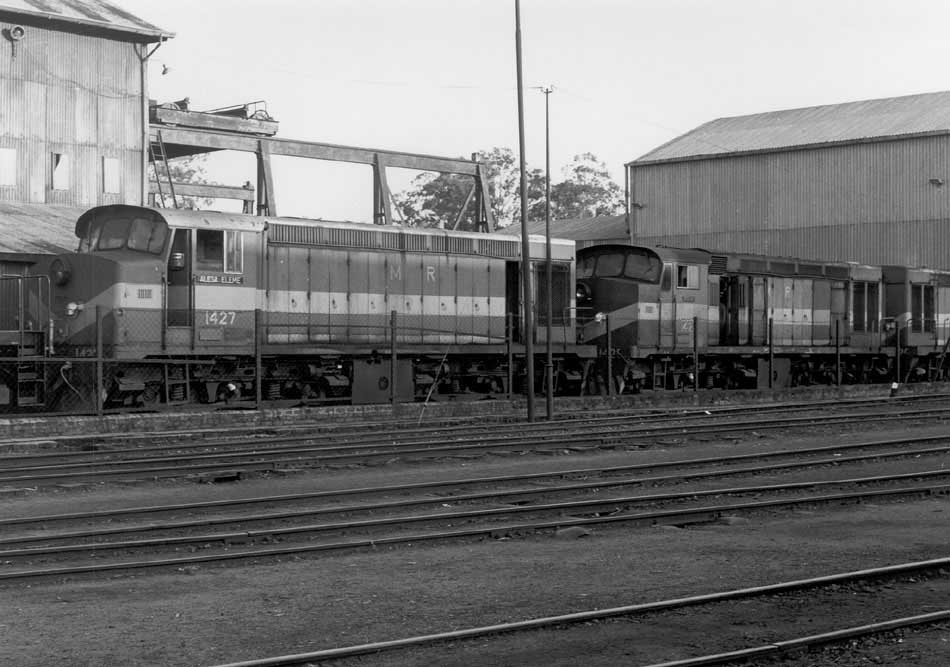

A year later in November 1989 another visit revealed few changes. 400 & 409 were noted working. 400 was on the Limbe - Blantyre shuttles whilst 409 was working ballast trains between Nansadi & Namatunu. 403 - 406 were still on loan to Mozambique (Beira line) with 405 (?) written off. 401/402/407/408 were working the Nacala line, usually to Gwamba and occasionally Nampula. 402/407/408 were later noted arriving at Limbe for servicing. 408 arrived with Shire Class 501 on a goods train, 402 arrived light, it had been attached to 407, but 407 had failed at Mudi and arrived the next morning attached to 400 on the shuttle. All these locomotives had armour plated cabs, as presumably did 401.
The four Station Class locomotives were still out of service, but the possibility of increased traffic suggested their return to service was imminent. 1425 only required minor repairs, 1426/27 were in running order, just requiring minor adjustments. 1428 however had a cracked engine block requiring major repairs, which were probably never received - the locomotive was withdrawn by March 1994.

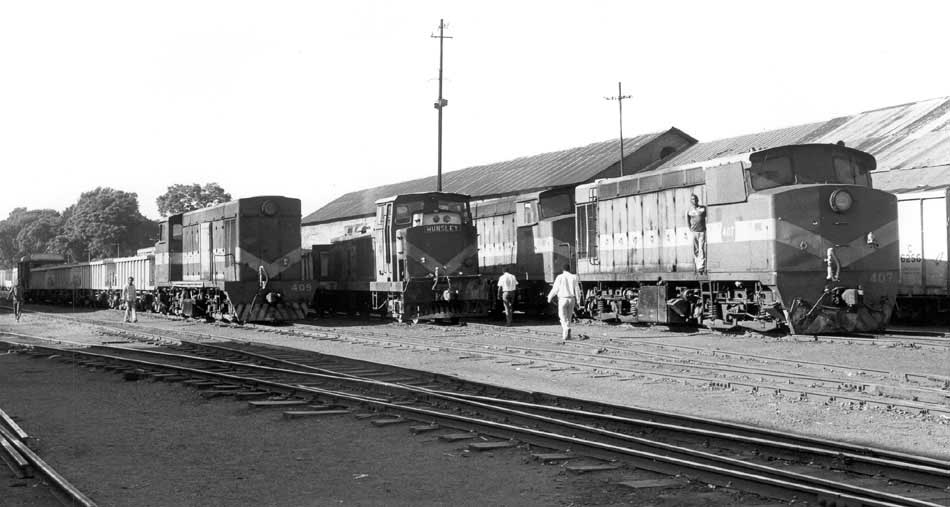
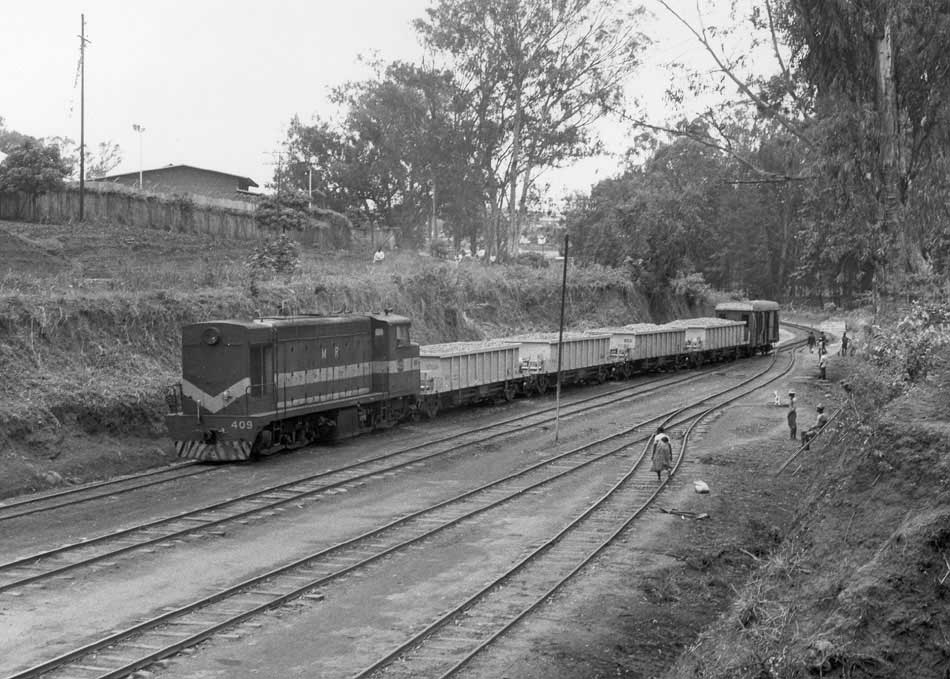
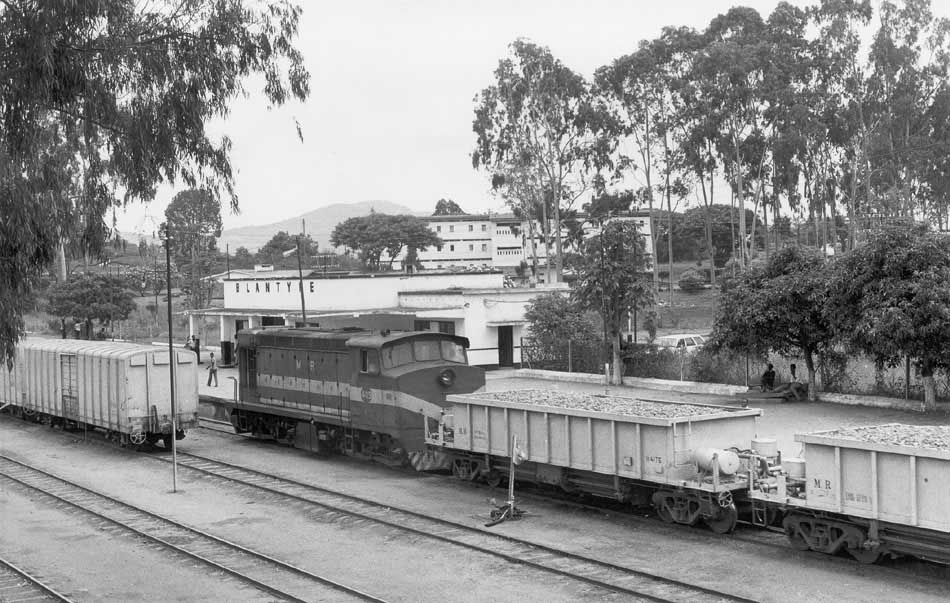
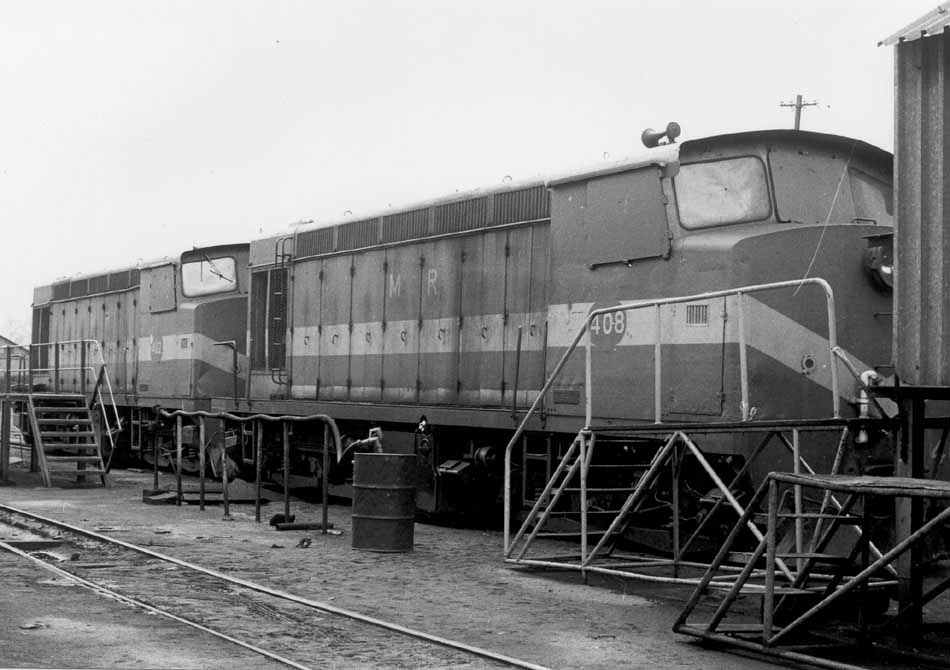
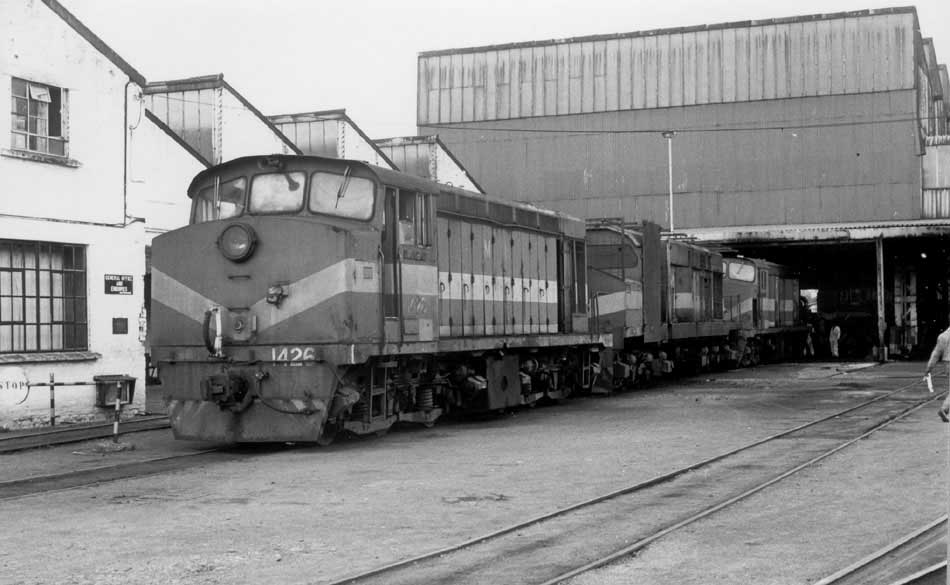
![]()
In early 1997 405 & 406 were reported 'in the Works' at Limbe, as opposed to 'for sale'.
Phil from Norway advises that the locomotives were still present at Limbe in 1998. Also noted were two locomotives recovered from Mozambique (off the Trans-Zambesia section; 403/404?), apparently having sustained considerable damage, they were undergoing evaluation for possible repair(?)
The new operator of the former Malawi Railways - Central East African Railways (CEAR) acquired ex-Zambia 1425/26/27/28 for possible rebuilding as slugs.
The entire former TZR line was abandoned, suffering from rebel attacks and was heavily mined, though attempts are in the works to repair & re-open the line from the southern end. The CFM fleet still exists:
206 at Sena
207/09/11/14 + one unidentified at Inhaminga
two unidentified at Dona Ana
Sena, Mocambique, September 2002

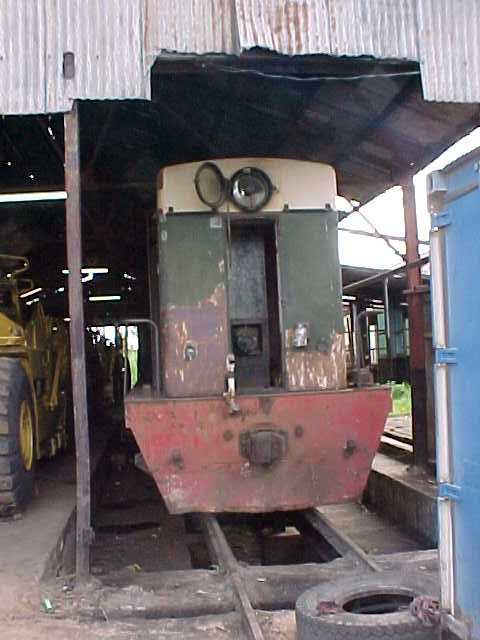
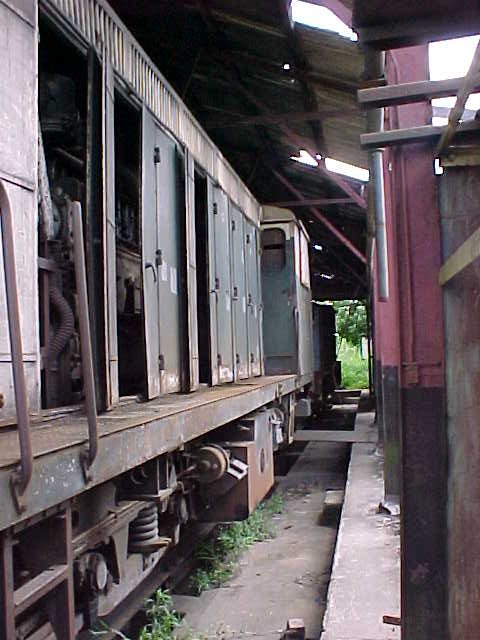
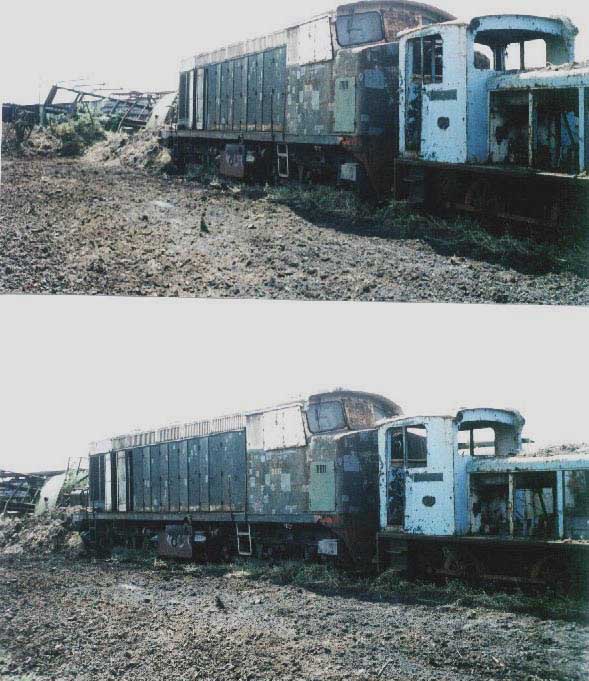
The civil unrest that included the operating area of the Malawi/CFM locomotives left many of the diesels scattered up and down the line, the Mocambique portion of this route in particular, along with much of the country being in-undated with thousands & thousands of un-exploded land mines.
This might explain the isolation of CFM 206 on the south side of the Zambesi on the Sena Sugar Estates at Marromeu, Mocambique, seen here in September 2002 with a very uncertain fate. A second Sena mill was located on the north bank nearer the sea at Luabo. Marromeu was reached by a branch line off the Beira - Malawi route from a junction at Inhamitanga. The branch line, like the mainline was virtually destroyed during the conflict.
October 1997 Limbe Shops
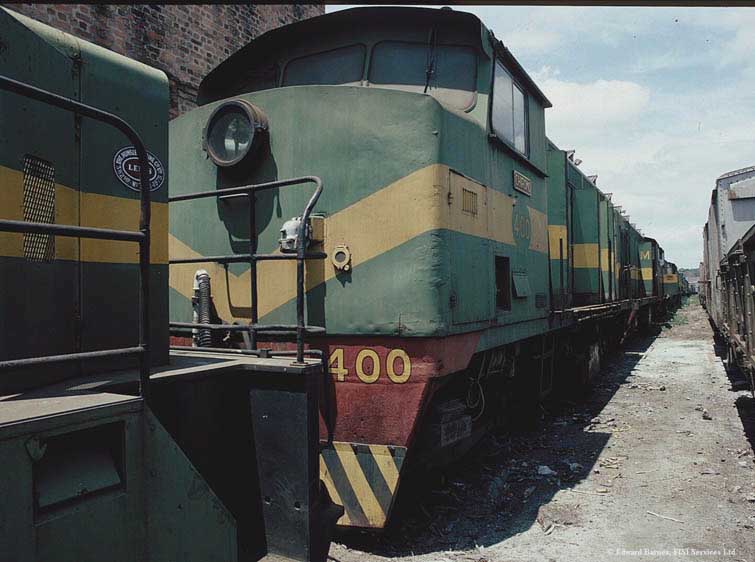
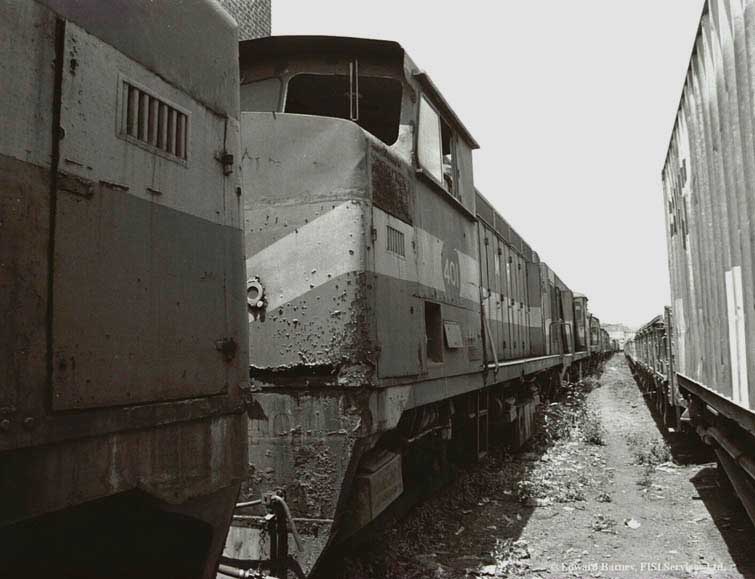
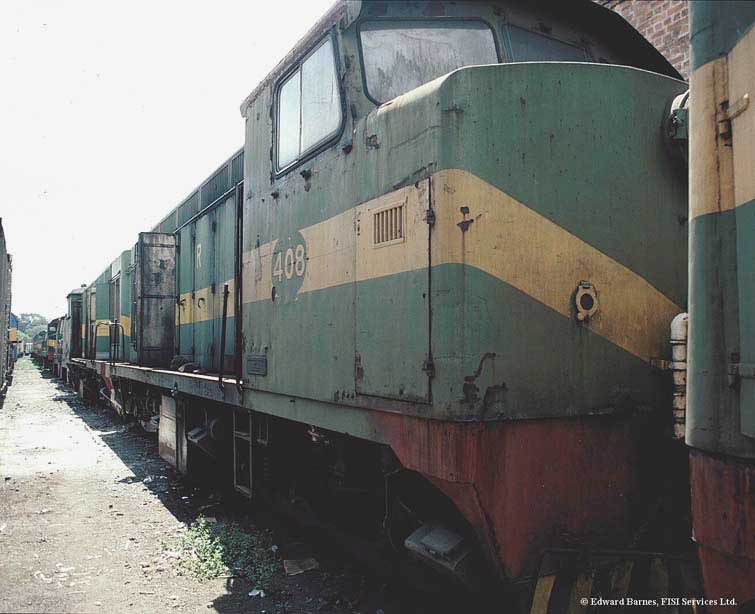
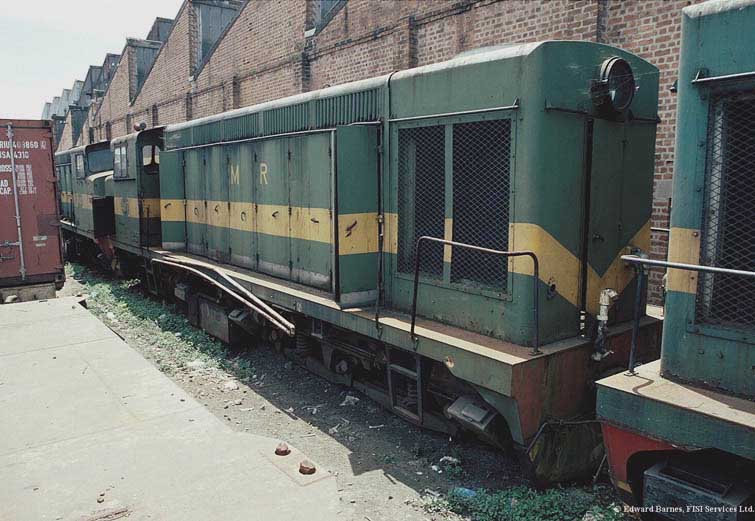
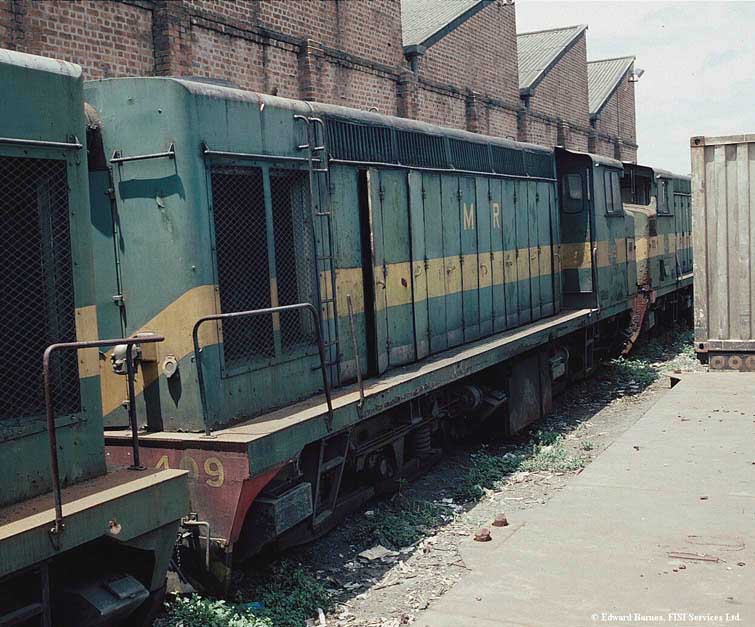

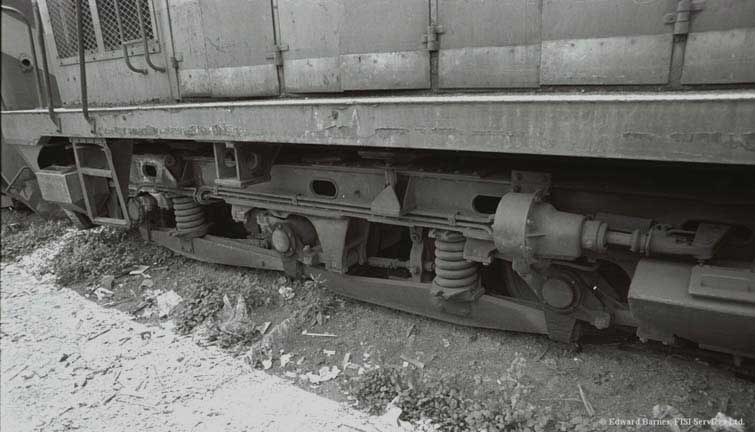
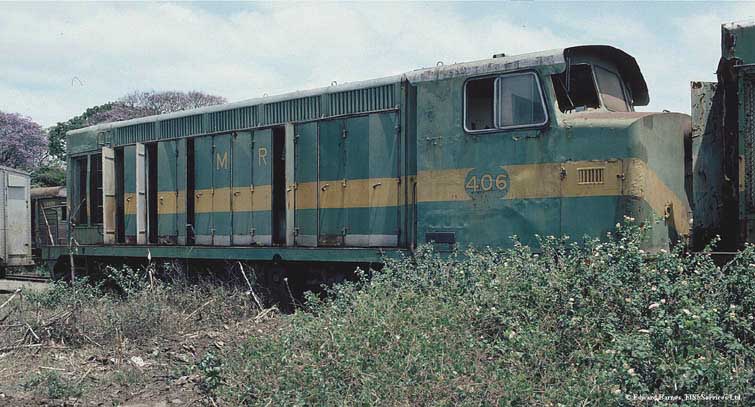
Above eight views courtesy Eddie Barnes.
A visit to Limbe Shops by Eddie Barnes in October 1997 found 400/01/02/05/06/07/08/09 in store. (403/04 were dumped on the Mozambique section of the former TZR - at Inhaminga - having been hired out to CFM by MR.) Eddie reports 405 was missing much of its nose & side. These locomotives were not acquired by the CEAR in March 2002 and were sold by the government to a scrap company.
400 was named "Chiromo", apparently the only member of the class to carry a name. The name was probably applied after the locomotive was acquired by Malawi Railways.
![]()
September 2008, Limbe Shops
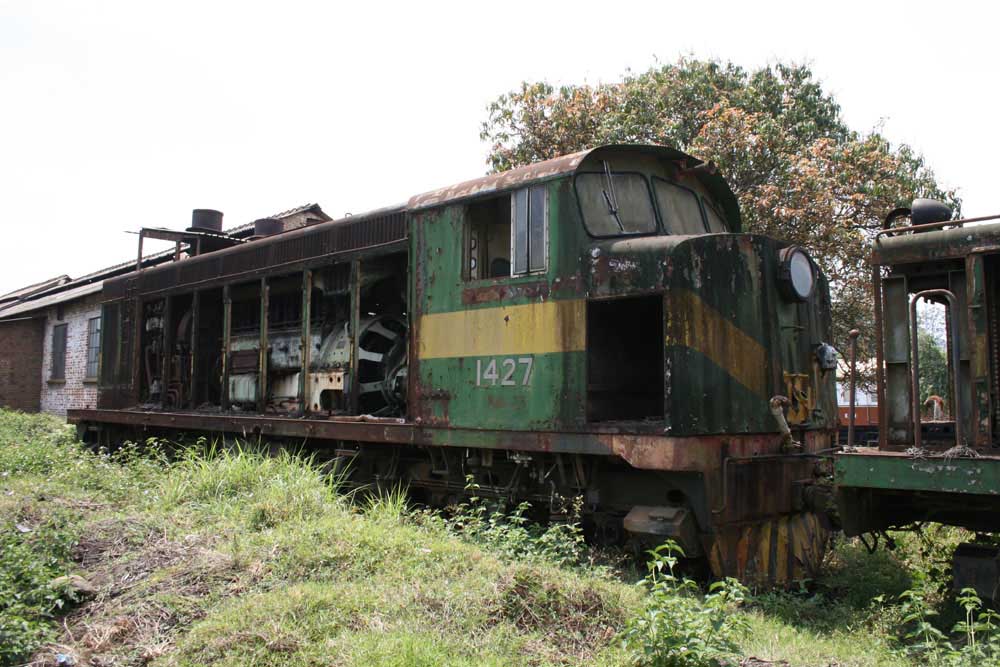
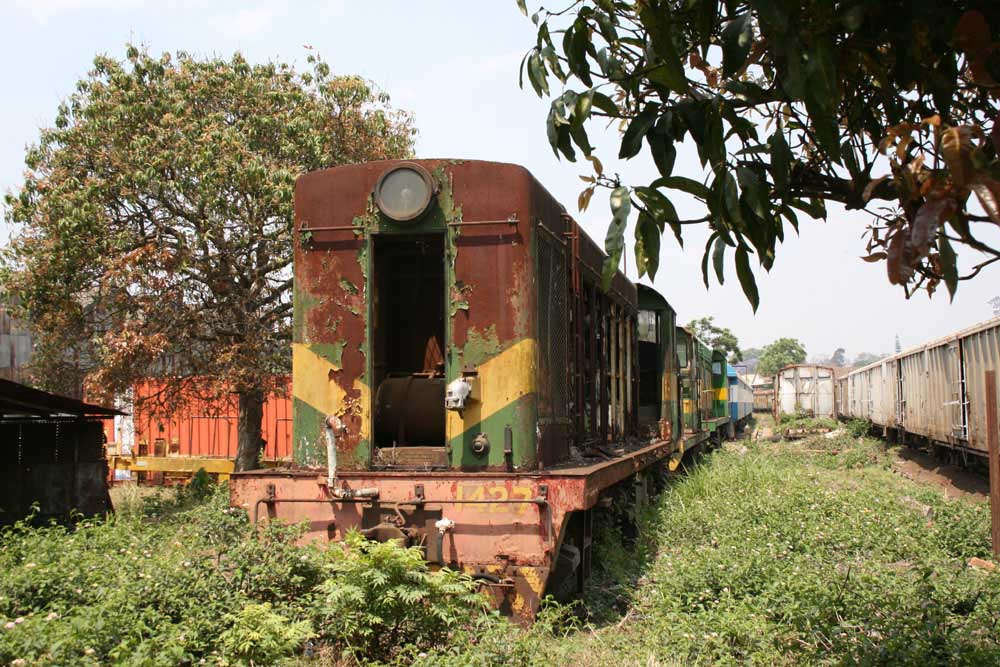

The above three views feature two of the Station Class locomotives; 1427 and cosmetically touched up 1428 photographed during September 1978. No.1428 had been cosmetically restored to participate in a recent rail event.
1426, 1427 and 1428 are still lying in Limbe Depot. There was no sign of 1425, although it could be hidden away elsewhere at Limbe. (Vic Lines).
![]()
Gauge: 3ft 6in
Nigeria Railways took delivery of twenty nine locomotives from Metropolitan Cammell/AEI in two seperate orders in 1964 & 1966. The 1964 order was valued at GBP2,200,000, with the locomotives planned to work between Lagos & Kano. The 1966 order of four locomotives (1425 - 1428) was to replace four of the earlier group transferred to Malawi Railways - the Zambian Government initially held ownership of these four locomotives. All were powered by the Sulzer 6LDA28C power unit, rated at 1,400hp. This was the same power unit as fitted to the Commonwealth Railways Tulloch built NT class.
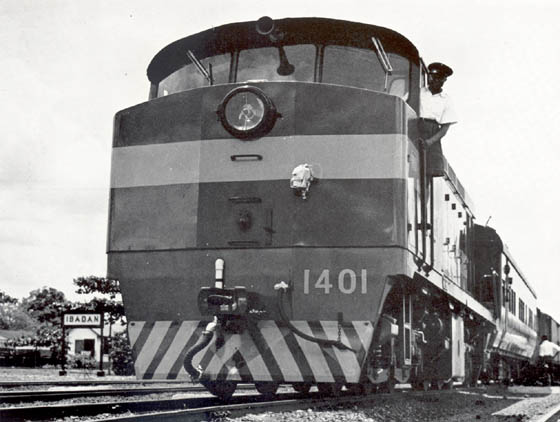
The increased horsepower over the earlier units was made possible by increasing the rpm to 800. On the Nigerian fleet the generators -AEI model TG5302W - were of a type found in many Alco locomotives operating worldwide. Electronic automatic derating devices were fitted to some of the Nigerian order, this method derates only when required, rather than blanket mechanical methods.
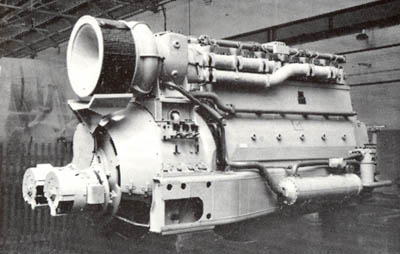
Dynamic brakes were also fitted to at least the last two (1st batch, 1428 & 1429) of Nigerian locomotives. These did not find good utilisation on the generally undulating Nigerian routes. One however was transferred to Malawi for use on a line that featured an elevation change of 3,600 feet in 66 miles. Over this route the advantages of the dynamic brakes was well noticed.
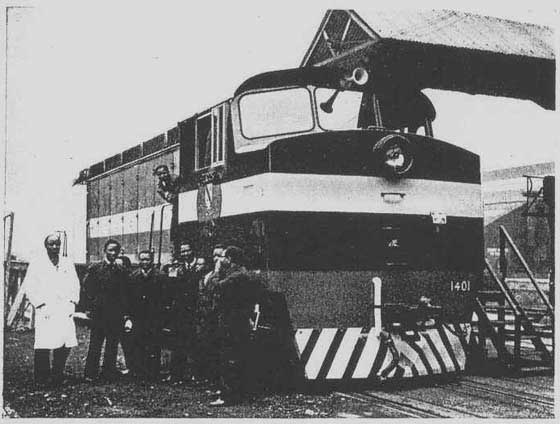
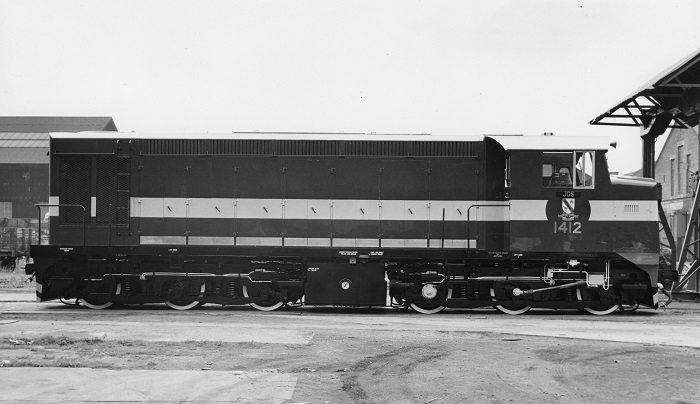
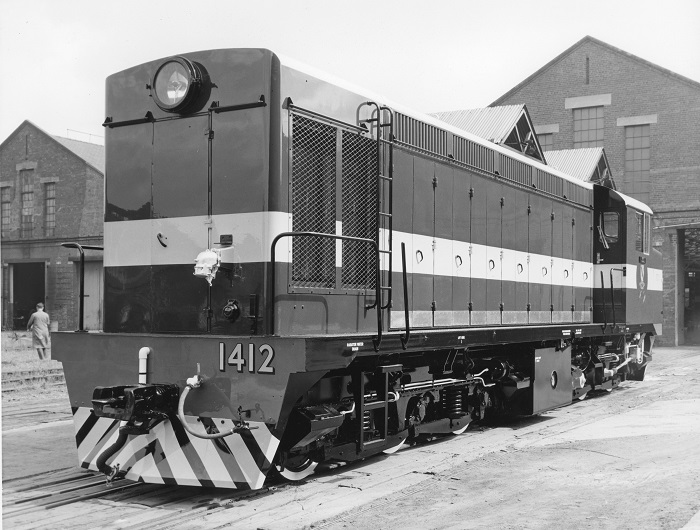
All twenty nine locomotives carried names of major towns & cities on the railway routes.
By the 1990's the locomotives were reported in store in Lagos, although one was noted in service during 1992. The last four in service (1404/06/28/29) were repainted in blue and white livery for the re-launching of the passenger services in the north of the country, but these were out of use by 1997. It is believed the whole fleet remained intact but out of service when 2000 rolled around.
![]()
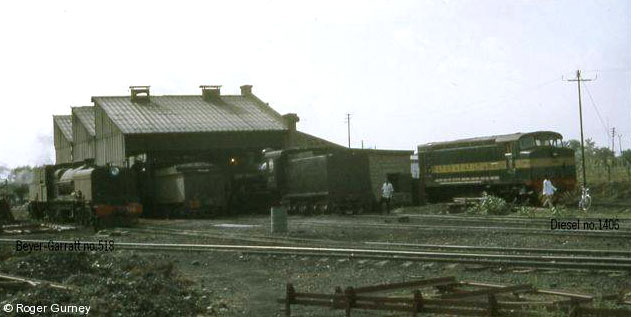
![]()
The views below have been graciously provided by Allan Ralston who spent many years living in Nigeria. The views are taken around the town of Funtua which is about fifty miles north of Zaria on the Zaria - Kaura Namoda line. Three of the views depict the AEI/MC/Sulzer locomotives, the fourth shows the typical track condition, all views reveal the geography of the area and the type of trains running circa 1976.
Locomotives featured include 1408 'Kaura Namoda' (top left) and 1414 (bottom left).
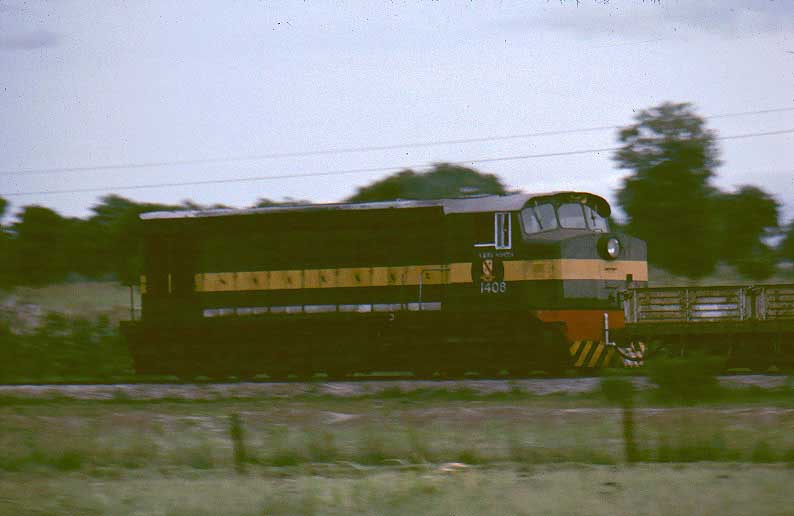
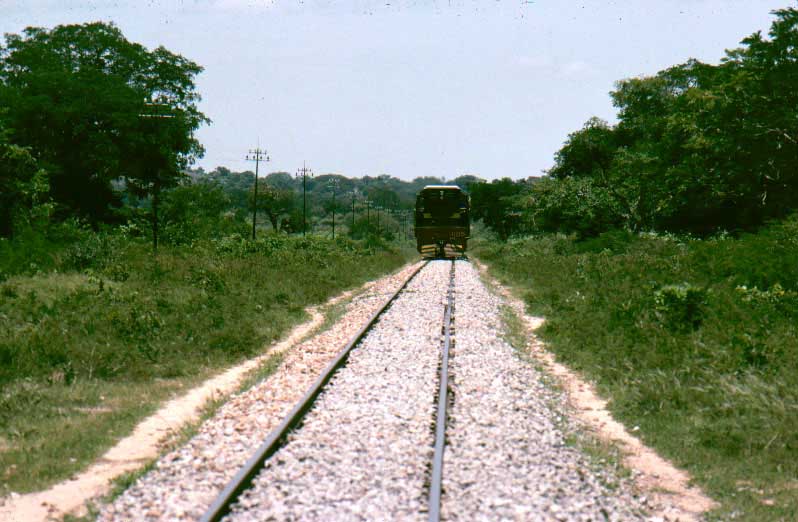
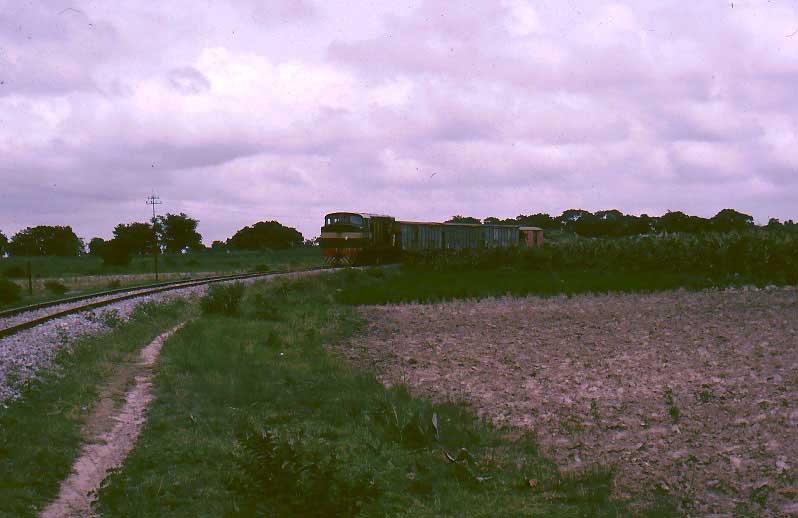
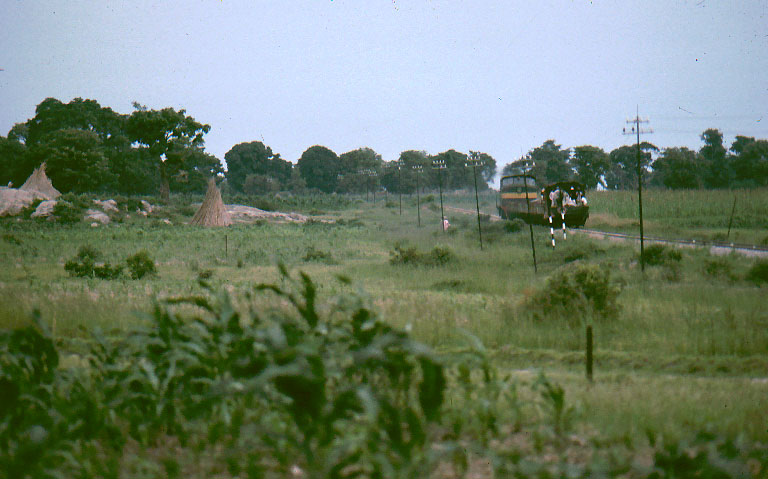
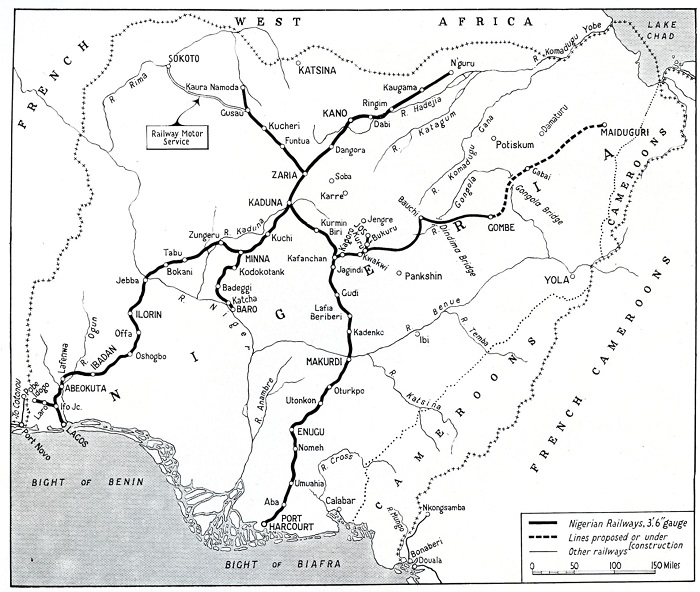
![]()
For more information on the Nigerian Sulzers click Here
Based on an articles in the Railway Gazette April 1963 & September 1967, various communications from the World Diesel Loco (Yahoo) group & material in various AEI publicity brochures.
![]()
Page added November 27th 2002.
Page updated March 28th 2024.
Return to Sulzer list page of traction units
Return to site menu